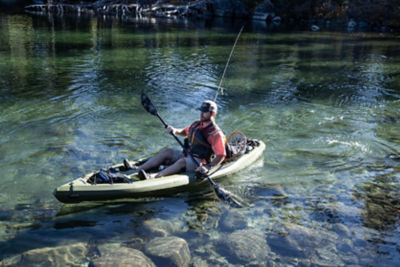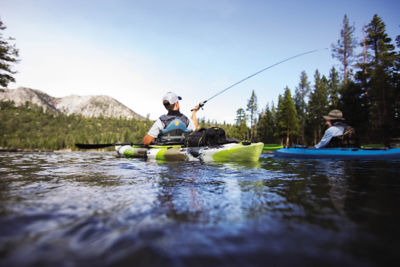Understanding Baitcasting Reels
Baitcasting reels can seem complex to amateur anglers, but a general knowledge of the parts at play can help carry your casts to new distances. Know the ins and outs of your reel design with these angling tips.
For many anglers taking to the streams, ponds and lakes this year, a baitcaster can be a quality reel choice for landing a trophy bass. The feel of the line and increased casting accuracy can help bass fishermen pull those prized fish from even the smallest of honey holes.
Baitcasters can be more advanced than their spincasting counterparts, so understanding their various components is a necessity if you’re going to use one. DICK’S Sporting Goods Associate and tournament bass fisherman Brendan Conlon explains that there are three general parts to baitcasting reels that you should know.
Not only can this information help you work through potential problems (casts falling short of your target, the dreaded bird’s nest, etc.), you can eventually fine tune each mechanism to fit your preferences for premier fishing performances.

THE DRAG
Usually located on the side near the handle of the reel, the drag is used to set and regulate the tension placed on the line while fighting fish. Conlon says that the more you tighten the drag, the harder it becomes for the bass to peel off more line.
“If you’re flipping and pitching in heavy cover, you probably want that drag turned all of the way down so you can really get those fish out of heavy cover,” Conlon says. “If you’re throwing a drop shot or a lightweight presentation, you might want to loosen that up a bit, give [the fish] a little bit of play with your lightweight lines and that sort of thing.”
BRAKING SYSTEM
The braking system on a baitcasting reel is designed to regulate the spool’s rotation during your cast, similar to how the brakes in your car work against your tires.
“If you add more brakes to your reel when you cast, it’s going to provide a little bit more resistance on that spool,” Conlon says. “It’s really going to keep you from getting a really big bird’s nest, but it’s also going to affect your casting distance.”
Conlon suggests that amateur baitcast users should start off with more brakes on in order to get a feel for the reel. As anglers become more comfortable with their equipment, they can let up on the brakes and begin to experiment with longer casts.
SPOOL TENSION KNOB
In addition to the baitcasting reel’s braking system, you can also adjust your spool speed with the spool tension knob. While braking systems are great for larger restrictions on how much line comes off, the spool tension knob allows for even finer tuning. For this reason, anglers use this mechanism to adjust for different lures that feature varying weights, helping to give them the perfect ratio for casting.
“Adjust [the knob] a little tighter or looser so that you can get a good casting distance with your specific bait that you’re using that day,” Conlon says.
Baitcasting reels can be intimidating to novice anglers, but overcoming that fear by understanding how they work can help you flip, pitch, cast and jerk your way to your next big fish story. Use these helpful breakdowns to understand your fishing setup and hook into a wonderful time on the water.
Complete your bass fishing setup with unstoppable line and hook combos. Discover our guides on the Three Best Fishing Lines for Bass Fishing and the Best Hooks for Bass Fishing, too.








